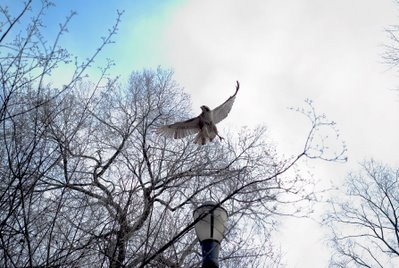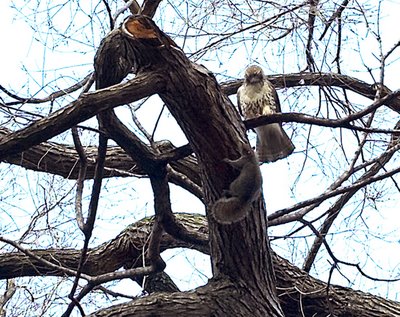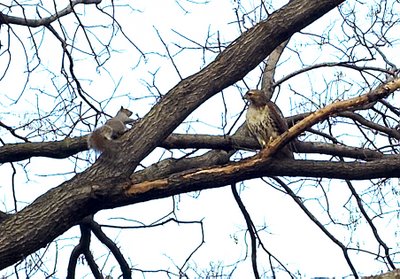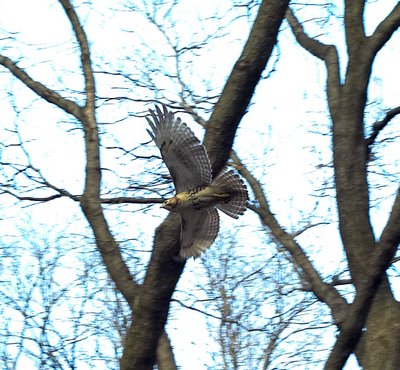Sunday, December 31, 2006
A Hawk with Hopes of a Fresh Squirrel Lunch




Swooping down from a tree limb to grab a squirrel from the lawn or from the side of a tree is just a part of a Red Tailed hawks daily routine and as many times as a hawk executes this maneuver in a day one would think that any hawk even a young and inexperienced one should be able to procure a fine afternoon repast of fresh squirrel with an hour or so of effort . But Saturday afternoon in Tompkins Square Park such was not the case : two hours of effort and not so much as even a tuft of Squirrel fur for the hawk pictured here . To make matters worse , in nearly every tree that the hawk chose to perch , watch and swoop down from there was a tastey resident there to harrass and taunt our hungry and inept hunter .
Sorry that some of the images are not as sharp as usual but I only had a 37 mm equivalent focal length lens on the camera , a lens that is much too short for photographing hawks in and among the trees of TSP. Some of the images required some enlargement .
Comments:
<< Home
http://austringer.net/wp/?p=470
There’s two comments to go with that. First, a lot of juvenile RTHs (as the barred tail on the one in the photos leads me to believe this one is) die in their first winter. If I recall correctly, the figure generally bandied about is about 70% mortality. An inept juvenile may be entertaining, but I can assure you that the issue is deadly serious for the bird. Squirrels are tough prey, fast, thick-skinned, and fully capable of biting off an RTH toe if the bird bungles the grab. Rusty, our 15-year-old very well-experienced Harris’s hawk will only bind to a squirrel if she is sure that she can get the squirrel’s head under control.
Second, the general poor ratio on prey capture attempts and successful catches for raptors like RTHs is what makes falconry possible. As one falconer put it, an RTH makes 20 attempts and catches once, where an osprey makes 20 attempts and fails to catch once. It is easy for a falconer to improve an RTH’s food acquisition ratio and convince it that hanging around the falconer is a good thing. It is generally considered very difficult to impossible for a falconer to successfully train and fly an osprey (harking back to the unregulated days pre-1918 when such could be considered); an osprey doesn’t need the falconer for anything.
-- Wesley R. Elsberry
There’s two comments to go with that. First, a lot of juvenile RTHs (as the barred tail on the one in the photos leads me to believe this one is) die in their first winter. If I recall correctly, the figure generally bandied about is about 70% mortality. An inept juvenile may be entertaining, but I can assure you that the issue is deadly serious for the bird. Squirrels are tough prey, fast, thick-skinned, and fully capable of biting off an RTH toe if the bird bungles the grab. Rusty, our 15-year-old very well-experienced Harris’s hawk will only bind to a squirrel if she is sure that she can get the squirrel’s head under control.
Second, the general poor ratio on prey capture attempts and successful catches for raptors like RTHs is what makes falconry possible. As one falconer put it, an RTH makes 20 attempts and catches once, where an osprey makes 20 attempts and fails to catch once. It is easy for a falconer to improve an RTH’s food acquisition ratio and convince it that hanging around the falconer is a good thing. It is generally considered very difficult to impossible for a falconer to successfully train and fly an osprey (harking back to the unregulated days pre-1918 when such could be considered); an osprey doesn’t need the falconer for anything.
-- Wesley R. Elsberry
Yes this is a juvenile and most every fall and winter there are a few that visit the parks here in NYC.Some years they actually take up residence for a few months in the Tompkins Square Park roosting every night in the trees of the park . 3 years ago I photographed two different juveniles sleeping on the same night in TSP in a sleet storm .Both of these hawks stayed in and around the park for 3 months
The hawk shown here is one of two that visits TSP almost every day . One seems to be a more effecient and sucessful hunter than this one .It is certainly true that this juvenile is in a precarious situation by not being able to fly well enough to catch more food .And you are correct in that this individual may not survive .
I've noticed that most of the more mature ones will not go for squirrel because of all that you noted .If you are a squirrel hunter you know from experience that squirrels are certainly one of the toughest animals to skin....and they can bite ,I know this from intimate experince with squirrels .
I've watched these hawks all my life in other parts of the country and here as well and am impressed that they can survive as well as they do . I believe that unlike most other birds of prey their numbers are increasing ,nonetheless many young ones fail and die .
I've noticed one other problem that must affect their flying and that is that some of these juveniles have lost pinion feathers ,which must affect how well they can control there travel among the trees . Several that I have seen in TSP over the last few years seem to have lost several feathers .
The hawk shown here is one of two that visits TSP almost every day . One seems to be a more effecient and sucessful hunter than this one .It is certainly true that this juvenile is in a precarious situation by not being able to fly well enough to catch more food .And you are correct in that this individual may not survive .
I've noticed that most of the more mature ones will not go for squirrel because of all that you noted .If you are a squirrel hunter you know from experience that squirrels are certainly one of the toughest animals to skin....and they can bite ,I know this from intimate experince with squirrels .
I've watched these hawks all my life in other parts of the country and here as well and am impressed that they can survive as well as they do . I believe that unlike most other birds of prey their numbers are increasing ,nonetheless many young ones fail and die .
I've noticed one other problem that must affect their flying and that is that some of these juveniles have lost pinion feathers ,which must affect how well they can control there travel among the trees . Several that I have seen in TSP over the last few years seem to have lost several feathers .
The feather problems can indeed make the difference between marginally surviving and simply not being up to the challenge. I am saddened at reports of raptors not making it, though as a wildlife biologist it is something that I expect. It doesn't mean that I have to like it.
I also like photography. My first professional-grade camera was a rangefinder, but on the large end of the scale, a 6x7 cm Koni-Omega Rapid. I'm now using a Nikon digital SLR as my primary photographic tool, though I have to admit that it has been years since I used film. I haven't managed to part with my Nikon F2 or N90s film bodies. The Leica M8 sounds like a pretty cool system, especially for someone with M-series lenses. It's probably way out of my comfort zone financially. In looking over your weblog, it seems like you have a good eye and fast recognition of moments. I especially like the hawk and squirrel photo with the squirrel pretty much underneath the hawk. Is it the 28mm lens that you had available that day?
-- Wesley R. Elsberry
I also like photography. My first professional-grade camera was a rangefinder, but on the large end of the scale, a 6x7 cm Koni-Omega Rapid. I'm now using a Nikon digital SLR as my primary photographic tool, though I have to admit that it has been years since I used film. I haven't managed to part with my Nikon F2 or N90s film bodies. The Leica M8 sounds like a pretty cool system, especially for someone with M-series lenses. It's probably way out of my comfort zone financially. In looking over your weblog, it seems like you have a good eye and fast recognition of moments. I especially like the hawk and squirrel photo with the squirrel pretty much underneath the hawk. Is it the 28mm lens that you had available that day?
-- Wesley R. Elsberry
I would normally go to TSP with my Canon 5D with a 70 t0 200mm f 2.8 zoom with the doubler in the optical system to give me 140 to 400 mm and have a 24 to 70 f2.8 zoom on my Canon 1Dmk II for in close action. Sometimes these Red Tails actually get so close that their wings brush my shirt so it is necessary to be equipped for long range shooting and very up-close shooting also . I doubt that it is that way in the wild but in the city parks one can very easily end up in if not actual contact something very close to it . I have spent several falls and winters studying and photographing thes and other park animals in the parks of NYC.
The M8 isn't at all suited to most wildlife shooting but when its the only camera that you have with you when the animal shows up you use it .On this day I was using the 28 mm f2 asph.
The M8 is indeed expensive but for most of what I do it is the better camera . I used M6 s for years in the streets here photographing another type of wild life that includes cops ,criminals ,crazy people ,protesters whatever .There is an earlier post covering a protest against police brutality on wallstreet just before Christmas which is more like what the bulk of my shooting is .
Post a Comment
The M8 isn't at all suited to most wildlife shooting but when its the only camera that you have with you when the animal shows up you use it .On this day I was using the 28 mm f2 asph.
The M8 is indeed expensive but for most of what I do it is the better camera . I used M6 s for years in the streets here photographing another type of wild life that includes cops ,criminals ,crazy people ,protesters whatever .There is an earlier post covering a protest against police brutality on wallstreet just before Christmas which is more like what the bulk of my shooting is .
Subscribe to Post Comments [Atom]
<< Home
Subscribe to Comments [Atom]

